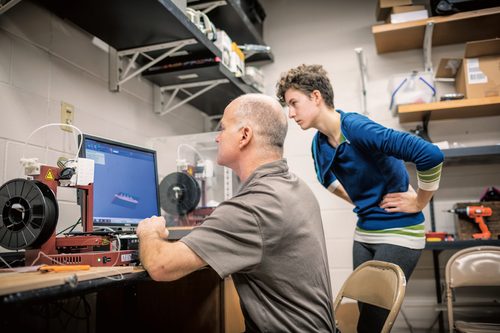 When classics professor Chico Zimmerman arrived at Carleton 27 years ago, nobody had a desktop computer. Now he can’t imagine life without one. “I couldn’t do what I do without technology,” Zimmerman says.
When classics professor Chico Zimmerman arrived at Carleton 27 years ago, nobody had a desktop computer. Now he can’t imagine life without one. “I couldn’t do what I do without technology,” Zimmerman says.
Although he teaches in an ancient discipline, Zimmerman says the classics have always been progressive in embracing technology. His own class features a “flipped classroom” which switches the lecture and homework portions of the course by assigning students to watch a video-recorded lecture before class so they can do more hands-on work during class time. Now, instead of lecturing for 30 minutes and working with students for 20 minutes, Zimmerman can devote the entire class period to questions, practice, and discussion.
As with any new teaching method or tool, support for faculty members is critical. “Putting your content online is not just a simple thing,” says Janet Russell, Carleton’s director of academic technology. That’s where Russell and her staff come in, offering pedagogical support for faculty members who want to implement new technologies—software as well as hardware. Software applications are becoming more and more personalized, Russell notes. For example, adaptive learning tools can push content to an interactive website, where students struggling with different concepts are led down different paths to suit their learning needs. Software tools can also give teachers a snapshot of all the questions the class answered incorrectly, enabling them to focus their lecture time more effectively.
Political science chair Greg Marfleet has seen firsthand the benefits of technology training. He once attended a summer consortium where he “stumbled onto” a class on computational modeling. There he learned about an open source program called NetLogo, which analyzes complex systems.He returned to campus to design an original course called The Complexity of Politics, using the new software. “To stay at the forefront of teaching, we’ve got to constantly train if we want to be relevant—and help our students be relevant,” Marfleet says.
Marfleet sees open source software as a promising avenue for teaching tools, because it is released free of charge with permission to use, adapt, and redistribute it. Another trend he notes is bring-your-own-device classes. When students bring their laptops and smartphones, any class can become a lab. “They can install the program, work with the data, and have the flexibility of working anywhere,” he says. This is essential, he adds, because demand for physical lab space is always high.
Professors need more than new tools and tech support to revitalize their courses, however, says art professor Stephen Mohring. His department has a new 3D printer that will make transforming a drawing into an actual object easier, but he says the more important tool he has received this term is the extra time to determine how to best integrate the technology into his class, thanks to a targeted opportunity grant. “We teach so intensively at Carleton,” Mohring says. “And when you’re teaching that intensively, you can’t think deeply about doing something different. The only time we have to think about improving our classes is when we’ve been given grants to do that, to be released from a class or two.”
Mohring credits trustee Jack Eugster, who has supported several targeted opportunity grants, for understanding the needs of faculty development. “He makes a point to have a conversation with the professor who’s going to be affected by the time he’s giving them. And he gets to see the excitement in our eyes when we talk about what we’re going to be doing—and that excitement is like a kid’s just before digging into a bag of Halloween candy,” Mohring says. “I don’t think any of us is happier here than when we get time to really think about teaching. After all, that’s why we’re in this game.”
 Bob ’62 and Carolyn ’63 Nelson
Bob ’62 and Carolyn ’63 Nelson
Nelson Endowed Fund for Online Resources
Carolyn Nelson ’63, a former Yale bibliographer, was working on a digital poetry index in 2011 when she realized she couldn’t access many essential online resources. At the same time, she and her husband, Bob, were exploring potential uses for their pledge to Carleton. The couple’s serendipitous solution to both issues? Providing funds for Gould Library to purchase extensive research databases.
“The more electronic resources faculty members have, the more research they can do,”Carolyn says. She and Bob didn’t want life at Carleton to be a struggle for faculty members accustomed to large research libraries at their graduate schools. Plus, the benefits also trickle down to students, allowing faculty members more flexibility to assign the use of primary sources in their courses.
Giving to Carleton, Bob says, is a reflection of the attachment he and Carolyn have to Carleton, a connection they share with two of their children, Eric Nelson ’89 and Melissa Nelson ’91. “We think a lot of the success we’ve enjoyed is due to Carleton,” he says.
